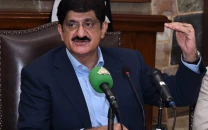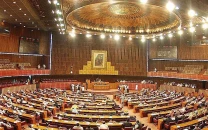To cut carbon, Sindh taps into the wind and the sun
Province seeks to add more than 4,000 megawatts to the national grid through wind and solar power plants

PHOTO: FILE
According to a senior minister, the provincial government is looking to add another 2,485 megawatts of electricity to the national grid using nothing but wind. “Some 12 companies have started the construction of new wind-powered electricity plants in the Thatta and Jamshoro districts,” said Sindh Energy Minister Imtiaz Shaikh. “Both districts form a wind corridor that we are working to tap into.”
Some 24 wind-powered electricity plants are already contributing 1,235 megawatts to the national grid, Shaikh said. “These power plants were set up under the federal government's Alternative Energy Development Board in Thatta district,” he pointed out.
“Now, the Sindh government’s energy department has issued letters of intent for setting up 35 wind power projects in the wind corridor of Thatta and Jamshoro,” the minister said. “Upon completion, and 12 of them will be completed next year, these plants will generate 2,485 megawatts. The 12 plants due to be operational next year alone will produce 610 megawatts of renewable energy,” Shaikh added.
Wind is not all the Sindh government is looking to tap into to both meet the province’s energy needs and mitigate the climate crisis. According to the minister, the provincial government has issued letter of intents for setting up 25 solar power projects in the province.
Once completed, the solar power plants due to be constructed in Thatta, Jamshoro, Shaheed Benazirabad and Sukkur districts will generate as much as 1,550 megawatts, he said. “Four of them have already obtained tariff and are waiting for formal approval from the federal government,” he told The Express Tribune.
A push for cleaner renewable energy could have come in Sindh sooner, provincial officials said. They blamed administrative hurdles from the federal government for holding up progress on this front. “The Sindh energy department had finalised agreements from six wind powered electricity plants in 2015,” said one official. “But the federal government imposed a ban on wind and solar power projects through an executive order on April 20 that year.”
The ban was imposed under the recommendation of the Federal Cabinet Committee on Energy. Due to the unilateral action of the federal body, the National Electric Power Regulatory Authority (NEPRA) stopped the process of awarding tariff to companies who had finalised their agreements pertaining to wind and solar projects with the Sindh government.
The move prompted then chief minister of Sindh, Qaim Ali Shah, to write a letter to then prime minister Nawaz Sharif. Shah, in the letter, argued that the cabinet committee’s decision would hold up development in the province.


















COMMENTS
Comments are moderated and generally will be posted if they are on-topic and not abusive.
For more information, please see our Comments FAQ